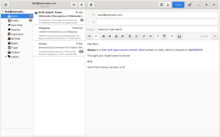E-mail program
An e-mail program (also called a mail client ) is a program with which e-mails are received, read, written and sent. E-mail programs are usually offered free of charge, often as free software . The most common ones include Apple Mail , Mozilla Thunderbird , and Microsoft Outlook .
In contrast to webmail , the software is usually used locally on the end device used - PC , mobile phone , tablet - and keeps an archive of all messages ready, which on the one hand enables the processing of e-mails even without an Internet connection and, on the other hand, secure communication under certain conditions ( e.g. via end-to-end encryption using Autocrypt ).
technology
To display an e-mail, an e-mail program can either open it directly on the mail server (usually via IMAP or IMAPS ) or download it from a mail server (usually via POP3 or POP3S ) and then open it locally in the Rule after it has been stored in a previously created user mailbox.
To send an e-mail, the user's e-mail program usually sends it via Simple Mail Transfer Protocol (SMTP) to an SMTP relay server (also known as a smart host ), which then forwards it to the recipient's mail server. The disadvantage of this procedure is that if the relay server cannot be reached, no e-mails can be sent.
Alternatively, the sending takes place via a locally available mail transfer agent (MTA), whereby the sendmail interface has become established for Linux or Unix , even if other mail transfer agents such as qmail , Postfix or Exim are used. This solution has the advantage of a local queue for outgoing e-mails and the disadvantage of a more complex installation.
configuration
An e-mail program usually requires the following information for configuration, which can be obtained from the Internet service provider :
- Address of the server for reading (IMAP server) or retrieving (POP3 server) the mails, as well as user name and password for retrieval
- Address of the server for sending (SMTP relay server) the mails, as well as user name and password for sending
Often the POP3 / IMAP and SMTP server addresses and their access data are identical.
As with access to other user accounts on the Internet, it is recommended that data transmission be encrypted, see Transport Layer Security . Otherwise the username and password can be intercepted; an attacker could read the e-mails or send e-mails via the user account. Since the beginning of 2014 freenet , t-online.de , GMX and Web.de have obliged their users to use encrypted connections to the mail servers (similar to HTTPS in the web browser). Regardless of the transport, the message text with metadata is cached in clear text on the servers involved.
organization
The user of the program usually has several folders available in which individual mails can be saved. Depending on the system and program, these folders are actual subdirectories in the computer's file system with individual files for each mail (see Maildir ) or archives in which several mails are packed together to save space. The archives can in turn be in "plain text" as text files (see mbox ) or as compressed archives, if necessary at the discretion of the user.
- Incoming mail is usually stored in an "inbox". The content of the folder is displayed to the user in the form of a list with the sender, subject and date of receipt, whereby the new, as yet unread mails are highlighted and can be read individually. Some programs allow you to define rules according to which mails are automatically distributed to several inbox.
- After reading it - or, in the case of spam , even before opening an individual email - the user can delete an email, which moves it to a " recycle bin ", similar to files. As with the latter, the emails are usually not deleted immediately, but only in a second step by emptying the trash . In the configuration, however, the user can often choose to skip this second step.
- If a mail is to be kept further, the user can move it to an "archive folder". He can create several of these, for example to save private and business emails separately.
- In addition, there is often a “drafts folder” in which sample mails are saved, which are to serve as the starting point for mails to be created later. This is also where e-mails that the user had created and actually wanted to send, but the latter broke off but did not want to completely discard the content that had already been created, also end up.
- When the user has sent an e-mail, it ends up in some e-mail programs first in an "outbox" before it is actually sent.
- The entries in the outgoing folder are automatically transferred to a “sent folder” after they have been sent successfully, so that the user always has a record of what he has sent.
The user can display the contents of all these folders in list form and read and reply to mails of his choice, use them as a starting point for a new mail to be created, delete them or move or copy them to another folder.
If the user has multiple user accounts , this folder structure may be created individually for each account .
The user can instruct the program to regularly check new mails that have arrived from the mail server.
Web links
Individual evidence
- ↑ E-mail, the electronic mail . Project "Consumers Safe Online", Technical University Berlin
- ↑ http://www.e-mail-made-in-germany.de/Verschluesselung.html
